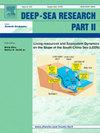澳大利亚西北部蓝鳍金枪鱼产卵区热带水域的微生物食物网动态
IF 3
3区 地球科学
Q2 OCEANOGRAPHY
Deep-sea Research Part Ii-topical Studies in Oceanography
Pub Date : 2025-09-13
DOI:10.1016/j.dsr2.2025.105547
引用次数: 0
摘要
虽然许多渔业的成功招募取决于幼虫与猎物丰度高峰的时间一致,但在热带/亚热带蓝鳍金枪鱼产卵区,如果较低但稳定的食物资源被较低的幼虫对远洋捕食者的脆弱性降低所抵消,则可能会减少。为了了解南蓝鳍金枪鱼(SBT)的幼虫栖息地特征,我们基于稀释孵育深度剖面的生长和放牧率,以及显微镜和流式细胞术(FCM)的碳生物量评估,对南蓝鳍金枪鱼(SBT)在西北澳大利亚(印度洋)产卵高峰期间的微生物群落碳流量进行了量化。两种基于chla的浮游植物产量估计值由于循环或混合营养作用而产生了不同的抵消,平均超过14C净群落产量(677±98和447±43 mg C m - 2 d - 1)。生产力高于墨西哥湾大西洋蓝鳍金枪鱼的产卵区,但低于海洋上升流地区的类似研究。小型浮游动物的平均放牧量为482±63 mg C m−2 d−1(占产量的71±13%)。原绿球藻的两个测量变量给出的平均产量和放牧率分别为282±36和248±32 mg C m - 2 d - 1(放牧率为86±6%)。原绿球藻几乎占SBT幼虫居住的上(0-25米)高光区生产和放牧通量的一半。原绿球藻数量减少,真核浮游植物和异养细菌在较低光带的相对重要性增加。这些结果描述了相对经典的开放海洋寡营养条件作为SBT幼虫营养流动的食物网基础。本文章由计算机程序翻译,如有差异,请以英文原文为准。
Microbial food web dynamics in tropical waters of the bluefin tuna spawning region off northwestern Australia
Whereas recruitment success for many fisheries depends on coincident timing of larvae with abundance peaks of their prey, less can be more in the tropical/subtropical spawning areas of bluefin tunas if lower but steady food resources are offset by reduced larval vulnerability to pelagic predators. To understand larval habitat characteristics for Southern Bluefin Tuna (SBT), we quantified microbial community carbon flows based on growth and grazing rates from depth profiles of dilution incubations and carbon biomass assessments from microscopy and flow cytometry (FCM) during their peak spawning off NW Australia (Indian Ocean) in February 2022. Two Chla-based estimates of phytoplankton production gave differing offsets due to cycling or mixotrophy, exceeding 14C net community production on average (677 ± 98 versus 447 ± 43 mg C m−2 d−1). Productivity was higher than in the Gulf of Mexico spawning area for Atlantic Bluefin Tuna but less than similar studies of oceanic upwelling regions. Microzooplankton grazing averaged 482 ± 63 mg C m−2 d−1 (71 ± 13 % of production). Two measurement variables for Prochlorococcus gave average production and grazing rates of 282 ± 36 and 248 ± 32 mg C m−2 d−1 (86 ± 6 % grazed). Prochlorococcus comprised almost half of production and grazing fluxes in the upper (0–25 m) euphotic zone where SBT larvae reside. Prochlorococcus declined and eukaryotic phytoplankton and heterotrophic bacteria increased in relative importance in the lower euphotic zone. These results describe relatively classic open-ocean oligotrophic conditions as the food web base for nutritional flows to SBT larvae.
求助全文
通过发布文献求助,成功后即可免费获取论文全文。
去求助
来源期刊
CiteScore
6.40
自引率
16.70%
发文量
115
审稿时长
3 months
期刊介绍:
Deep-Sea Research Part II: Topical Studies in Oceanography publishes topical issues from the many international and interdisciplinary projects which are undertaken in oceanography. Besides these special issues from projects, the journal publishes collections of papers presented at conferences. The special issues regularly have electronic annexes of non-text material (numerical data, images, images, video, etc.) which are published with the special issues in ScienceDirect. Deep-Sea Research Part II was split off as a separate journal devoted to topical issues in 1993. Its companion journal Deep-Sea Research Part I: Oceanographic Research Papers, publishes the regular research papers in this area.

 求助内容:
求助内容: 应助结果提醒方式:
应助结果提醒方式:


